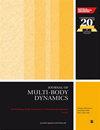三种信号分解方法在轴承故障检测与分类中的性能评价
IF 1.9
4区 工程技术
Q3 ENGINEERING, MECHANICAL
Proceedings of the Institution of Mechanical Engineers Part K-Journal of Multi-Body Dynamics
Pub Date : 2022-11-22
DOI:10.1177/14644193221136661
引用次数: 1
摘要
在本研究中,对信号分解方法进行了性能评价;采用变分模态分解、经验模态分解和集合经验模态分解对实验记录的滚珠轴承振动信号进行故障检测和分类。本文提出了一种结合能量、故障关联和豪斯多夫距离三种统计度量的混合敏感模态选择方法,并研究了分解方法提取的敏感模态对轴承缺陷频率检测的影响。对内滚道缺陷和外滚道缺陷进行了不同尺寸的健康故障和播种故障的振动数据采集。完整的特征数据集包括5个时域特征、4个谱域特征和2个非线性统计特征。k近邻、支持向量机和朴素贝叶斯分类器用于故障分类,并使用四个性能指标预测结果:准确性、灵敏度、精度和f分数。首先,采用混合敏感模态函数进行信号分解,并对状态指标(均方根、峰度和波峰因子)进行统计分析,结果表明VMD方法优于其他两种方法。其次,故障分类结果预测k近邻分类器优于其他两种分类器。该方法利用三种分解方法提取的选择模态函数特征,显著提高了轴承故障分类性能指标。本文章由计算机程序翻译,如有差异,请以英文原文为准。
Performance evaluation of three signal decomposition methods for bearing fault detection and classification
In the present study, the performance evaluation of the signal decomposition methods; variational mode decomposition, empirical mode decomposition, and ensemble empirical mode decomposition, for the ball bearing fault detection and classification for the experimentally recorded vibration signals has been done. This work proposed a novel hybrid sensitive mode selection method combining three statistical measures (energy-based index, fault correlation-based index, and Hausdorff distance-based index) and investigating the effect of the selected sensitive mode extracted by the decomposition methods for the bearing defect frequency detection. The vibration data have been acquired for the healthy and seeded faults of different sizes for the inner and outer raceway defects. The complete features dataset comprises five time-domain, four spectral-domain, and two non-linear statistical features. The k-Nearest Neighbor, Support Vector Machine, and Naive Bayes classifiers are used for fault classification and predict the results with four performance metrics: accuracy, sensitivity, precision, and F-score. Firstly, the results of signal decomposition employing hybrid sensitive mode functions and statistical analysis of condition indicators (RMS, kurtosis and crest factor) revealed that the VMD outperforms the other two techniques. Secondly, the fault classification results predicted that the k-Nearest Neighbor classifier outperforms the other two classifiers. This proposed novel sensitive mode selection method significantly improves the bearing fault classification performance metrics with the features extracted from the selective mode functions with all three decomposition methods.
求助全文
通过发布文献求助,成功后即可免费获取论文全文。
去求助
来源期刊

CiteScore
4.10
自引率
11.10%
发文量
38
审稿时长
>12 weeks
期刊介绍:
The Journal of Multi-body Dynamics is a multi-disciplinary forum covering all aspects of mechanical design and dynamic analysis of multi-body systems. It is essential reading for academic and industrial research and development departments active in the mechanical design, monitoring and dynamic analysis of multi-body systems.
 求助内容:
求助内容: 应助结果提醒方式:
应助结果提醒方式:


